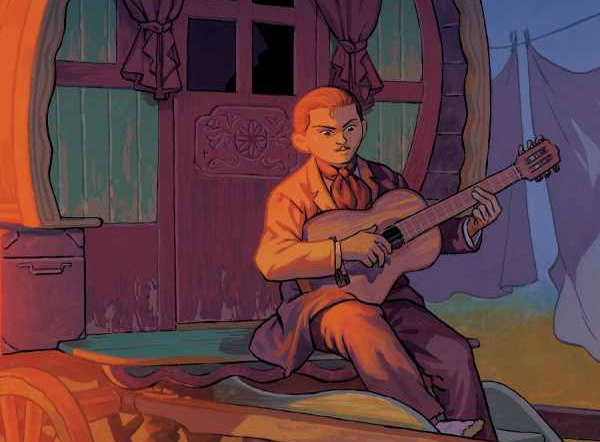
DJANGO, Hand on Fire, kills two birds with one stone by having a separate mini-biography and a graphic novel. Other comic biographies by nbm have had biographies in between the chapters of the graphic novels, which tell the story of the artist/group from the cradle to the grave (or present-day if they are still amongst the living).
DJANGO, Hand on Fire begins with the graphic novel focusing on his childhood up until a fire damaged the guitarist’s left hand along with the slow and painful steps he took to regain his skills as a result of the deformation of his left hand, resulting in the fire whilst also reinventing himself. The mini-picture biography fills in the gaps of Django Reinhardt’s short life (he died aged 43) and the notable musician’s he worked with, including Duke Ellington.
The graphic novel focuses less on celebrating the songs he played and the artists’ he worked with or even the fact that he is regarded as “France’s greatest guitarist”; but rather, it’s “a story of overcoming tremendous handicap” as well as an insight into Reinhardt’s Romany gypsy heritage. There is much emphasis on Django’s name, which means “he who wakes”. The foreword provided by French singer and jazz manouche Thomas Dutronc describes Django Reinhardt as a “gypsy/ manouche” and a free man who liked French classical artists, including Ravel and jazz.
This graphic novel briefly touches upon Reinhardt’s birth in 1910 before skipping to 1922, where we see a young man who neglected his studies (he never learned to read), prone to getting into trouble (he allegedly derailed a tram!) and fighting other children desperately wants to play the banjo. Eventually, his mother Négros is able to afford a six-string banjo guitar she allegedly procured from an African-American gentleman who had immigrated to Paris. The young Django was naturally adept with his new instrument and was confident enough to soon approach bands to jam with and play in.
Whether it was Django’s insistence on always having a guitar pick, the underage adolescent could join local bands who only ever entertained having legal aged adults amongst their ensemble. His first break and the first time he entered the world of the “gadje (the non-Roma)” was when Django was invited to play with accordionist Vettese Guerino’s band. At this time, Django begins to get ideas about travelling the world, being successful in America, meeting his future wife Irna (nicknamed Naguine for her rosy complexion, which resembled France’s wild cherries) and develop a taste for gambling (playing cards and losing).
Django’s many accomplishments, including having a record out by the time he was 18 (where his name was misspelt owing to his illiteracy) and recording and touring with The Jack Hylton orchestra are explored; but the main focus is on the incident when Django’s caravan caught on fire which left him with third-degree burns. Interestingly part of his recovery involved switching from the banjo to the guitar as he didn’t have to press so hard on the guitar strings. Django continued to play left-handed but learned to rely more on the fingers, which weren’t damaged.
From the graphic novel with fantastic colour depicting the grit, toil, passion and soul of the characters involved (including a Catalonian bear) comes the mini-biography, which provides more facts about the artist, his heritage and how his family came to settle in the outskirts of France (a 30 square mile area known as “The Zone”). Whilst his father left the family home when Django was young, he did teach him the gypsy violin and cimbalom (a type of dulcimer). Afterwards, Django’s music tuition came from his uncle and cousin. The mini-biography comes with a generous selection of photographs, including those with him and his family, Duke Ellington and a powerful image of a close up of the deformities and burns to his left hand following the fire.
DJANGO, Hand on Fire, through the medium of the graphic novel, has adroitly focused on “the most dramatic portion” of his life whilst giving an interesting reflection of his cultural background and his perseverance which enabled him to become “France’s greatest guitarist”. The accompanying mini-biography fills in many of the gaps outside the graphic novels’ remit of this unique artist. Apart from not offering a selective playlist to accompany the music behind the life and legend of this fascinating personality and musician, the mini-biography does almost everything else.


1 Trackback / Pingback